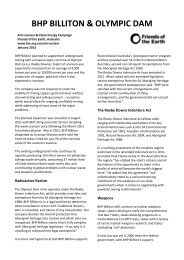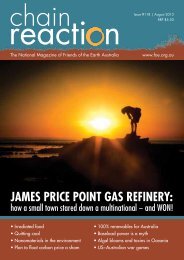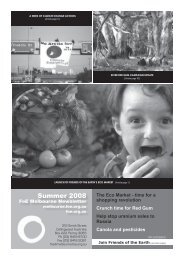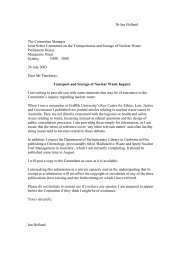Yellowcake Country? - Friends of the Earth Australia
Yellowcake Country? - Friends of the Earth Australia
Yellowcake Country? - Friends of the Earth Australia
You also want an ePaper? Increase the reach of your titles
YUMPU automatically turns print PDFs into web optimized ePapers that Google loves.
No safe dose.<br />
Radiation is everywhere, right<br />
So why worry about radiation from<br />
<strong>the</strong> nuclear industry<br />
Bill Williams<br />
Radiation is energy travelling through space:<br />
<strong>the</strong> earth is ba<strong>the</strong>d in this energy, it’s a part <strong>of</strong><br />
our habitat. There is a spectrum <strong>of</strong> radiation<br />
energies, from radio waves, through micro<br />
and light waves, to ionising radiation — <strong>the</strong><br />
radiation emitted by <strong>the</strong> building blocks <strong>of</strong><br />
matter, or atoms. Certain atoms, such as<br />
uranium, are said to be unstable or radioactive,<br />
that means <strong>the</strong>y have excess internal energy<br />
which <strong>the</strong>y release in <strong>the</strong> form <strong>of</strong> gamma<br />
rays, or alpha or beta particles. Through <strong>the</strong>se<br />
spontaneous emissions, called decay, <strong>the</strong><br />
radioactive atom eventually disintegrates into<br />
a totally new atom. All <strong>the</strong> time, <strong>the</strong> atom is<br />
progressing in one or more steps towards a<br />
stable state where it is no longer radioactive.<br />
This radiation is referred to as ionising because<br />
electrically-charged particles called ions are<br />
produced in <strong>the</strong> materials it strikes.<br />
Gamma rays, similar to X-rays, represent<br />
energy transmitted in a wave without <strong>the</strong><br />
movement <strong>of</strong> material, but <strong>the</strong>y have great<br />
penetrating power and can pass through <strong>the</strong><br />
human body. Thick barriers <strong>of</strong> concrete, lead or<br />
water are used as protection from <strong>the</strong>m.<br />
Alpha particles have a positive electrical<br />
charge and are emitted from naturally occurring<br />
heavy elements such as uranium and radium, as<br />
well as from some human-made elements, such<br />
as plutonium. Because <strong>of</strong> <strong>the</strong>ir relatively large<br />
size, alpha particles collide readily with matter<br />
and lose <strong>the</strong>ir energy quickly. That means <strong>the</strong>y<br />
have little penetrating power and can be stopped<br />
by <strong>the</strong> first layer <strong>of</strong> skin or a sheet <strong>of</strong> paper.<br />
However, if alpha sources are taken into <strong>the</strong><br />
body, say by breathing or swallowing radioactive<br />
dust, <strong>the</strong>y can inflict more severe biological<br />
damage than o<strong>the</strong>r radiations.<br />
Beta particles are fast moving negatively<br />
charged electrons and are much smaller than<br />
alpha particles. They can penetrate up to two<br />
centimetres <strong>of</strong> human flesh.<br />
Ionising radiation is well known for its<br />
capacity to damage human tissue: at high doses<br />
this can result in massive cell death, organ<br />
damage — particularly bone marrow and gut<br />
— and death.<br />
Even at relatively low doses, ionising<br />
radiation can cause damage to <strong>the</strong> genetic<br />
code, or DNA, <strong>of</strong> living organisms, including<br />
humans. If DNA abnormalities caused by<br />
radiation are passed onto <strong>the</strong> next cell<br />
generation <strong>the</strong> abnormal coding can lead to<br />
tissue abnormalities, typically cancers. Even<br />
at very low doses, cancers have been detected<br />
in exposed populations. Because <strong>the</strong> cancer<br />
will take many cell generations to develop, it<br />
may be several decades before it is detected. If<br />
<strong>the</strong> damage to <strong>the</strong> DNA code occurs in <strong>the</strong> egg<br />
or sperm <strong>the</strong> coding error may be passed onto<br />
<strong>of</strong>fspring, potentially resulting in birth defects<br />
and even cancers.<br />
So we exist in a naturally radioactive<br />
environment, <strong>the</strong> rocks, mountains and <strong>the</strong><br />
sun in particular produce a background<br />
level. However, human activities in <strong>the</strong> past<br />
century have significantly increased our<br />
exposure to ionising radiation, through atomic<br />
weapons development, testing and use, as well<br />
as uranium-mining and nuclear electricity<br />
generation.<br />
Unfortunately <strong>the</strong>re is no level <strong>of</strong> radiation<br />
exposure below which we are at zero risk:<br />
even low-level medical exposures such as chest<br />
X-rays carry a quantifiable risk <strong>of</strong> harm. While<br />
high doses <strong>of</strong> ionising radiation will cause<br />
greater health damage, even low doses are<br />
associated with adverse environmental and<br />
human consequences.<br />
Radiation health authorities use scientific<br />
modeling to calculate and set permissible limits<br />
for ionising radiation exposure. As <strong>the</strong> scientific<br />
techniques have become more sophisticated,<br />
<strong>the</strong> recommended exposures for <strong>the</strong> public<br />
and <strong>the</strong> workforce have steadily been reduced<br />
— levels once regarded as safe are now known<br />
to be associated with cancers, bone marrow<br />
malignancies and genetic effects. Current<br />
levels <strong>of</strong> recommended exposure are again<br />
under challenge as <strong>the</strong> techniques <strong>of</strong> molecular<br />
and radiation biology become increasingly<br />
refined, revealing micro-damage to intracellular<br />
structures.<br />
That means even current permissible<br />
levels <strong>of</strong> exposure are likely to undergo fur<strong>the</strong>r<br />
downward revision. That means, <strong>the</strong>re’s simply<br />
no safe dose.<br />
Dr Bill Williams is a member <strong>of</strong> <strong>the</strong> Medical<br />
Association for <strong>the</strong> Prevention <strong>of</strong> War<br />
(MAPW).<br />
Page 12
















